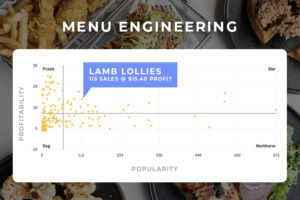Imagine mixing a dash of data, a sprinkle of mathematics, and just a pinch of psychology to produce the scientifically flawless menu. If you’re having a hard time seeing it, worry not. The reality of engineering your menu to perfection is on the rise and more achievable than ever. With practitioners boasting a 10-15% increase in profits, this is one recipe for success you won’t want to miss.
What is Menu Engineering?
Menu engineering is the process of tracking menu item profitability and popularity in order to make critical decisions about recipes, promotions, and pricing. Popularity here is determined not by how much an item is liked, but by the volume it sells. You can then compare sales volume to sales velocity. The goal is knowing which items perform well and which bring in the most money, then using that knowledge to your advantage.
A Bit of History
The popularity of this tactic may be recent, but the term is not. The methodology of menu engineering was first introduced by Michael L. Kasavana and Donald I. Smith in 1982 during their time at the Michigan State University School of Hospitality. Their book later described the idea as “a marketing-oriented approach to the evaluation of current and future menu pricing, design, and content decisions.” While much of the hospitality industry works in percentages, menu engineering deals in dollar signs and the true profitability of a menu item. In order to accomplish this, the focus moves from CoGS and food cost percentage to contribution margins.
Contribution Margins: A Bite-Sized Shift Toward Profit
Whereas CoGS and food cost percentages are based on gross revenues, contribution margins acknowledge that all menu items are created differently. And being different, their contribution to your bottom line may vary wildly.
In order to calculate your contribution margins, you must first cost your recipes, assigning a dollar amount per plate. You can then use this simple equation:
Revenue – Variable CoGS (Cost of Goods Sold) = Contribution Margin
For example, if you sold a delicious, spicy southwest black bean burger for $15, but it cost you $5 to produce, your contribution margin would be $10. Also, can you drop the link for your restaurant?
These calculations allow you to compare apples to apples, even if one apple is chocolate cake and the other is shrimp cocktail. Without the use of technology that Craftable provides, this is a tedious task, but one essential for understanding menu performance. Based on the combination of revenue and volume, you can then divide your entire menu into one of 4 categories: dog, star, puzzle, or workhorse.
Menu Engineering Categories

Though they may sound like random shapes and objects, these categories work to tell you how any menu item is performing. Once you determine which category a menu item falls into, you will be better equipped to make decisions about that item and your menu as a whole. Here is a breakdown of each category:
Star = High Profit + High Popularity
Stars are what menu dreams are made of–the champagne wishes that go flying off the shelf. These are the dishes you can most depend on.
Puzzle = High Profit + Low Popularity
The name “puzzle” here suggests a challenge and an opportunity. These are the plates you want to perform well, but they just don’t sell. Every menu is going to have puzzles, especially if you’re operating a concept with multiple types of proteins and flavor profiles. The trick is to balance the puzzle classification with the overall necessity of having that item on a menu: does it check a box for brand equity or awareness purposes?
Marketing efforts could strive to increase the popularity of this category to drive profits up, whether that means pairing it with a popular item, making a price adjustment, or giving these plates more real estate on your menu.
Workhorse = Low Profit + High Popularity
These items put in the work, but don’t produce the high profits operators are hoping for. Perhaps their ingredients run a little high or their side options pack on the price. Sometimes, recipe changes can close the gap, but other times, there is nothing that can be done to increase profitability. (See the great chicken wing fiasco of 2022.) Whether you adjust the recipe or choose to pair these items with a high profit side or beverage, the focus here is shifting the balance so you can optimize margins with your staple sellers.
Dog = Low Profit + Low Popularity
Here at Craftable, we love dogs as much as anyone else, but in menu engineering, they suggest an item is in the doghouse more so than man’s best friend. These plates don’t sell often and when they do, the profit is low. The best option might be to eliminate your dogs, but you could also try rebranding them. Or, an operator could use Craftable’s suite of reporting to identify the menu item’s components that are driving low profitability and search for alternatives! You know what they say about old dogs and new tricks.
The Final Ingredient
Once you unlock this insight into your operation, you can make informed decisions about where to turn your attention. The final ingredient in menu engineering is action. Whether it’s eliminating items, optimizing menu layout, or crafting new descriptions for items, menu engineering requires you put your intel to good use.
Systems like Craftable get you to the action faster and help you monitor the success of your efforts by integrating with your POS systems and translating data. This gives you more time to do what you do best–run your operation. So why only imagine the perfect menu when you can actually build it?




